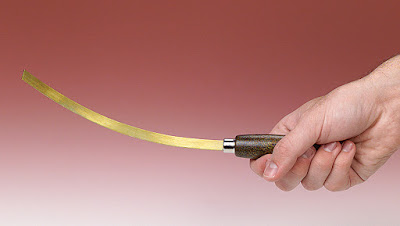Mechanical Temperature Measuring Devices (Bimetallic Strip & Thermometer)
MECHANICAL TEMPERATURE MEASURING DEVICES
A change in temperature causes some kind of mechanical motion, typically due to the fact that most materials expand with a rise in temperature. Mechanical thermometers can be constructed that use liquids, solids, or even gases as the temperature-sensitive material. The mechanical motion is read on a physical scale to infer the temperature.
Bimetallic strip thermometer
Two dissimilar metals are bonded together into
what is called a bimetallic strip, as shown in figure.
Bimetallic Strip
Suppose metal A has a smaller coefficient of thermal expansion than does metal B. As temperature increases, metal B expands more than does metal A, causing the bimetallic strip to curl upwards as sketched.
One common application of bimetallic strips is in home thermostats, where a bimetallic strip is used as the arm of a switch between electrical contacts. As the room temperature changes, the bimetallic strip bends as discussed above. When the bimetallic strip bends far enough, it makes contact with electrical leads that turn the heat or air conditioning on or off.
Another application is in circuit breakers High temperature indicates over-current, which shuts off the circuit.
Another common application is for use as oven, wood burner, or gas grill thermometers. These thermometers consist of a bimetallic strip wound up in a spiral, attached to a dial that is calibrated into a temperature scale.
 |
| Bimetallic Strip |
Pressure thermometer
A pressure thermometer, while still considered mechanical, operates by the expansion of a gas instead of a liquid or solid. There are also pressure thermometers that use a liquid instead of a gas
Suppose the gas inside the bulb and tube can be considered an ideal gas. The ideal gas law is PV = mRT, where P is the pressure, V is the volume of the gas, m is the mass of the gas, R is the gas constant for the specific gas (not the universal gas constant), and T is the absolute temperature of the gas.
Specific gas constant R is a constant. The bulb and tube are of constant volume, so V is a constant. Also, the mass m of gas in the sealed bulb and tube must be constant (conservation of mass).
A pressure thermometer therefore measures temperature indirectly by measuring pressure.
The gauge is a pressure gauge, but is typically calibrated in units of temperature instead.
A common application of this type of thermometer is measurement of outside temperature from the inside of a building. The bulb is placed outside, with the tube running through the wall into the inside.
The gauge is on the inside. As T increases outside, the bulb temperature causes a corresponding increase in pressure, which is read as a temperature increase on the gauge.



